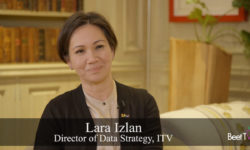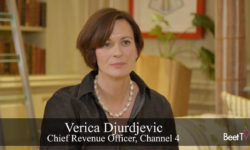LONDON, UK — In an ad industry that is now invested in developing metrics to quantify audience attention, paying attention to the audience could yield the ultimate in user behavior signalling.
Several tech vendors are now offering technology employing facial recognition to help quantify attention paid to programming and ads.
In this video interview at Beet.TV’s London summit in December, Nicolas Grand, SVP, Transformation, Global Investment, Omnicom Media Group, toled me how his agency is tapping into the tech.
The tracking team
Omnicom is working with a number of vendors offering eye-tracking tech:
- Amplified Intelligence
- Lumen
- PlaygroundXYZ
- Viomba
“On television it’s a little bit more complex because you need to use facial recognition – is that your mom, is that your friend visiting you, is that your dog?,” he said. “Actually, I know from experience dogs do watch television.
“There are two companies in the world that, that can do this well.
- “TVision – they have a big panel in the US and they’re launching a panel in the UK.
- “Amplified Intelligence – we have quite a lot of research with Amplified Intelligence, particularly on television viewing behaviours and how that relates to attention.”
How Reading Viewers’ Faces Can ‘Calibrate’ TV Measurement Data
Lean-forward TV
Agencies like Grand’s Omnicom are increasingly interested in quantifying attention, as the industry looks to redefine how upper- and mid-funnel media can be seen to provably perform.
“It’s not enough to make sure that an ad was served – you actually want confidence that the ad delivered attention,” Grand says.
While TV has always claimed a relatively high rate of viewer attention than digital media, Grand says connected TV (CTV) commands 20% greater attention, prompting him to consider it a “lean-forward experience”, even though the industry had typically considered TV generally a “lean-back” medium.
Privacy in mind
So, given digital ad tracking privacy concerns of recent years, how on earth could TVs that watch audiences faces, eyes and facial expressions fathomably gain application?
Because the vendors in the space use limited-size opt-in panels.
“At the moment, the TV panel in the US is based on 5,000 homes,” Grand says. “Obviously, we couldn’t have millions and millions viewers tracked that way. It will also probably not be very cost-efficient. Everything is based on opt-ins, and we’ve got some very, very clear or very strong protections around user privacy.
“No data that actually identifies the person ever gets uploaded to a cloud. All the data gets handled within the set top box.”
Proxy metrics
Grand says attention-centric “proxy metrics” offered by the likes of DoubleVerify can be re-tooled for TV.
Whereas such systems might look at display scroll speed to calculate an attention score, Grand says: “We can also apply those type of proxy metrics on the TV by looking at metrics such as a clutter, percentage of premium positions in the break or the percentage of contextually-relevant programmes that you’re buying in your campaign.
“The idea is that the more engagement we can create and the more signs of engagement, the higher the likelihood of attention.”
You’re watching ‘Looking Ahead: TV in Europe 2025’ a Beet.TV Leadership Summit presented by Magnite & Publica, in partnership with egta. All videos were filmed on-site at our event at London’s Soho Hotel. For more videos from this series, please visit this page.











































